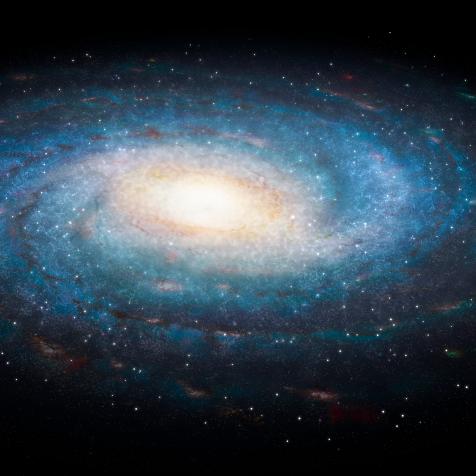
If the Universe Is Expanding, What Is It Expanding Into?
There's a short answer and a long answer to this mysterious question.
Sometimes, it's the simplest questions that have the most complicated answers. What's the speed of dark? What happened before the Big Bang? And if the universe is expanding, what is it expanding into? The answer to that last question has a short answer and a long answer — but trust us when we say you're going to want the long answer.

Getty Images/Thanapol sinsrang
Build Me Up, Buttercup
Here's the short answer: That question doesn't make sense. The universe is everything, so it isn't expanding into anything. It's just expanding. All of the galaxies in the universe are moving away from each other, and every region of space is being stretched, but there's no center they're expanding from and no outer edge to expand into anything else.
But that doesn't mean that the universe is infinite. That brings us to the long answer. To understand how something could be finite but have no edge, think of the fabric of the universe as the surface of a balloon. As the balloon inflates, the surface stretches and every point on that surface moves away from every other point, but a tiny being on the surface of that balloon could walk forever and never run into the edge of its balloon universe. There's no edge, yet that balloon universe has a finite volume.
The Shape of the Universe
But the balloon is just one example. Scientists aren't actually sure whether the universe is finite or infinite, or even what shape the universe is. There are three options: spherical, flat, or hyperbolic (that is, it curves upward). Evidence from the earliest light in the universe suggests that the second option is on the money, and the universe is, in fact, flat.
Even if the universe is flat and not balloon-shaped, however, it's still easy to think about how it could be finite with no edge. Think about a flat piece of paper. You could take two opposing edges and make them touch, creating a cylinder. If a tiny 2-dimensional rocket ship traveled from one of those edges to the other, it would arrive back where it started. You could do the same thing in the perpendicular direction: Connect the two ends of the tube to each other (pretend this is magically stretchy paper, for the sake of argument) and create a donut shape, also known as a torus. Now your 2-dimensional rocket ship could travel anywhere it likes, and it would never encounter an edge — even though your paper torus has finite volume.
But wait, you might be saying. Paper is flat; a torus is curved. Isn't that cheating? No, and that's because scientists have a very specific definition for the word "flat." When they say flat, they mean "Euclidean," which means that parallel lines always run parallel and the sum of the angles of a triangle is always exactly 180 degrees. This doesn't happen on a sphere or a hyperbola, but it does on a cylinder, a torus, and any other shape you can make out of a flat piece of paper.
This suggests something kind of exciting: If we live in a flat universe, you could potentially travel in one direction for long enough (or build a telescope that can see far enough) to end up right back where you started. Even cooler things happen when you think about other weird shapes — shapes that twist back on themselves could make you arrive back at a mirror image of where you started, for example.
But no matter what shape the universe is, it's not expanding into anything. There's nothing outside of the universe because the universe has no edge.
This article first appeared on Curiosity.com.


















